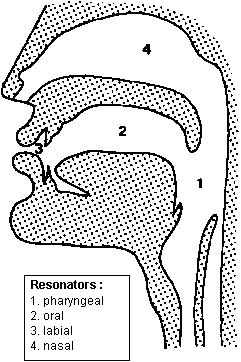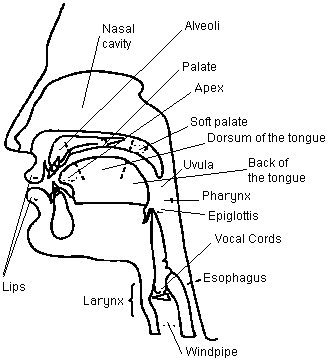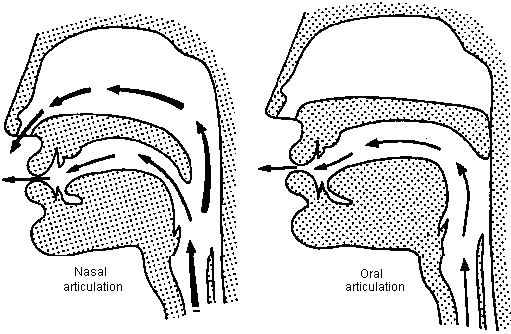Sound Production
Most sounds in speech are produced by passing a stream of air from the lungs through one or more resonators belonging to the phonetic apparatus.
The principal resonators are (see figure 1.1 below):
-
the pharyngeal cavity;
-
the oral cavity;
-
the labial cavity;
-
the nasal cavity.

Figure 1.1
The presence or absence of obstructions in the course of the airstream modifies the nature of the sound produced. By classifying the different types of obstructions that are possible, articulatory phonetics distinguishes the sound classes described below.
For a small number of articulations, the airstream does not originate in the lungs, but rather from outside. The "ingressive" airstream mechanism produces sound through inhalation. A speech sound can also be generated from a difference in pressure of the air inside and outside a resonator. In the case of the oral cavity, this pressure difference can be created without using the lungs at all (producing clicks, for example).

Figure 1.2: diagram of the speech organs
TOP ^
Consonants and Vowels
The distinction between consonants and vowels is made in the following manner:
- if the air, once out of the glottis, is allowed to pass freely through the resonators, the sound is a vowel;
- if the air, once out of the glottis, is obstructed, partially or totally, in one or more places, the sound is a consonant.
Before proceeding, it should be noted that the line between vowels and consonants cannot be clearly drawn; a continuum exists between the two extremes. There are also intermediate instances, such as the semi-vowels and the (frictionless) spirants.
TOP ^
Place of Articulation and Manner of Articulation
The distinction between manner of articulation and place of articulation is particularly important for the classification of consonants.
The manner of articulation is defined by a number of factors:
-
whether there is vibration of the vocal cords (voiced vs. voiceless);
-
whether there is obstruction of the airstream at any point above the glottis (consonant vs. vowel);
-
whether the airstream passes through the nasal cavity in addition to the oral cavity (nasal vs. oral);
-
whether the airstream passes through the middle of the oral cavity or along the side(s) (non-lateral vs. lateral).
The place of articulation is the point where the airstream is obstructed. In general, the place of articulation is simply that point on the palate where the tongue is placed to block the stream of air.
The place of articulation can be any of the following:
-
the lips (labials and bilabials),
-
the teeth (dentals),
-
the lips and teeth (labio-dentals -- here the tongue is not directly involved),
-
the alveolar ridge (that part of the gums behind the upper front teeth -- alveolar articulations),
-
the hard palate (given its large size, one can distinguish between palato-alveolars, palatals and palato-velars),
-
the soft palate (or velum -- velar articulations),
-
the uvula (uvulars),
-
the pharynx (pharyngeals),
-
the glottis (glottals).
TOP ^
Voice
A sound is described as voiceless when the vocal cords do not vibrate during its articulation. If the vocal cords do vibrate, the sound is called voiced. The vocal cords are folds of muscle located at the level of the glottis (in fact, the glottis is nothing other than the space between the vocal cords).
The vocal cords vibrate when they are closed to obstruct the airflow through the glottis (see Manner of Articulation above): they vibrate under the pressure of the air being forced through them by the lungs.
The voiced/voiceless opposition is mainly useful for the classification of consonants (voiceless vowels being very rare in the languages of the world).
TOP ^
Nasality
The top of the pharynx is like a crossroads. The airstream can exit the pharynx either of two ways, depending on the position of the soft palate:
-
if the soft palate is lowered, a portion of the air will pass through the nasal cavity (the remainder finding its way through the oral cavity);
-
if the soft palate is raised, access to the nasal cavity is cut off, and the air can only pass through the oral cavity.
The sounds produced via the first method are called nasal; those produced the other way, oral. The nasal/oral opposition concerns vowels as well as consonants.

Figure 1.3 nasals and orals
The nasal/oral opposition concerns vowels as well as consonants.
TOP ^
